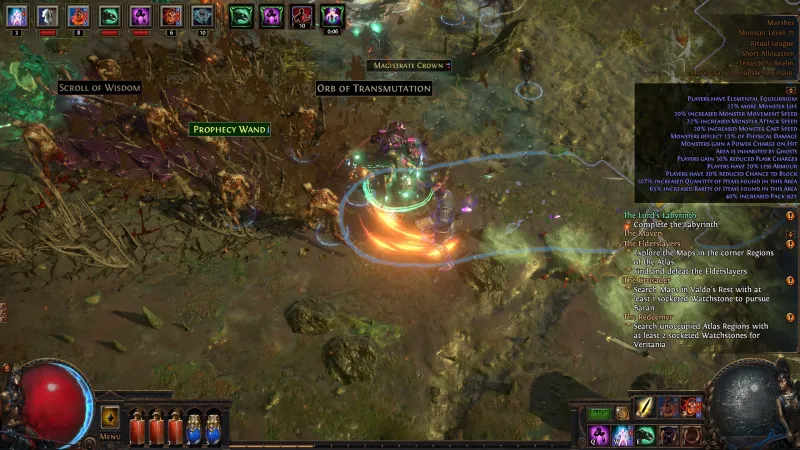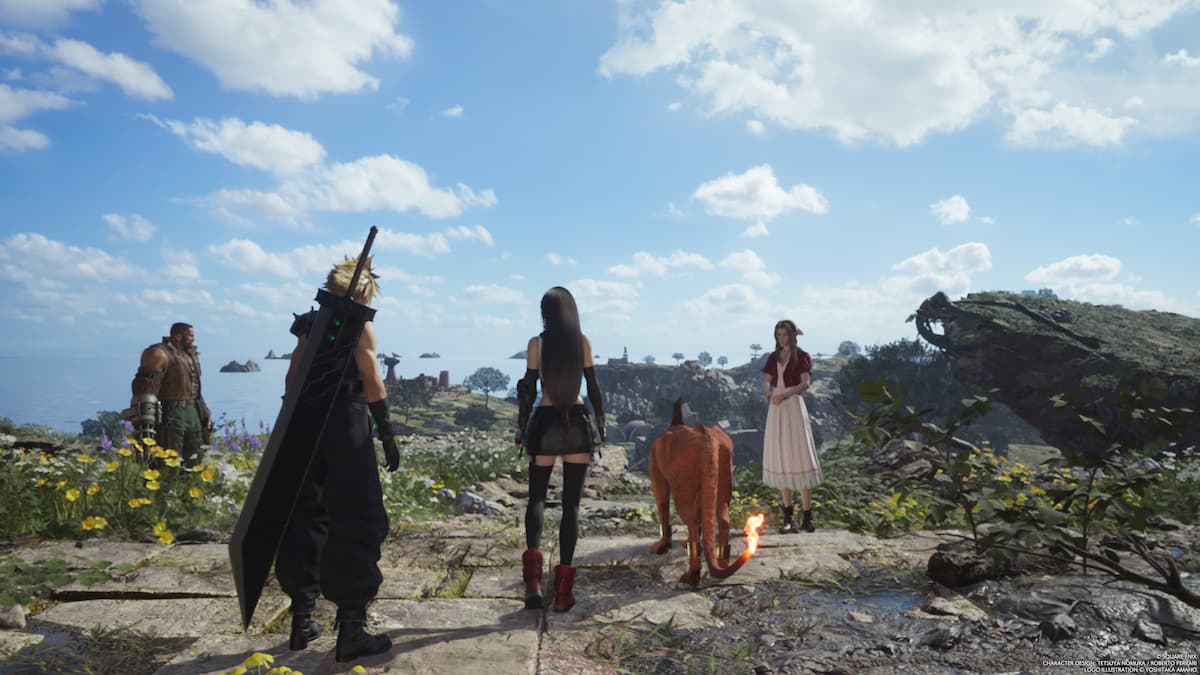
On Friday, a new Path of Exile league and content drop hit on PC, and it’s coming this week to console. I’ve played Path of Exile on and off for almost a decade now (with 500 hours logged on Steam), and each league guarantees at least a quick return to check out what’s new. Several of us at Game Informer are always going back to see what’s happening, check out Jeff Cork’s experience with the previous Heist league here.
With the latest Ritual league and Maven content, Grinding Gear Games concocts a potent brainworm that taps into their best-in-class action/RPG endgame cycle, but some of the framework constructed around other aspects of the game is beginning to feel rough. I basically played all weekend, leaving me with a cool level 85 Necromancer that’s likely just the beginning for my participation in this update. Yep. Level 85. I played … a lot. Let’s take a quick walk through Ritual, the Atlas, and Path of Exile.
Click here to watch embedded media
Answering Your Own Prayers
With Ritual league, you really get to have it your way when it comes to loot. While trading is part of the game, I’ve never enjoyed that aspect and prefer to find my own gear, up to and including playing in Solo Self-Found league. Unfortunately, when I play in that mode, I can’t use the guild bank to gear up all my friends, so standard leagues is generally where I end up. However, instead of gathering up a boatload of Chaos Orbs and trading for powerful items, I love to find my own gear and make do as I work my way through the campaign and the Atlas. Ritual gives players access to extremely powerful gear, high-end currency, and essentially agency over their own progression path as you bust through each screen, which adds a lot to the overall progression arc. No longer are you hoping for a good drop, you’re selecting exactly what you want and earning it, maybe over the course of several maps.
Ritual lets players purchase items with ritual points that you earn in each area. Can’t afford the big power items? You can defer the item to a future area, meaning you’ll see it again soon at a discount. You can defer items as many times as needed in order to get them at a reasonable price, which allowed me to snag a Tabula Rasa early on my character. Tabula Rasa is a huge early-game boost, giving the player access to a 6-link chest piece that you can slot in any color of gem. The downside of course is that the Tabula Rasa is truly a “blank slate” with no stats, so it’s a replaceable piece much later down the line.
Anyway, the key point here is that each and every area you enter is chock full of interesting choices to make. As you select gear or currency to purchase, it makes every location interesting and even overpowers whatever else you may be doing in the area in terms of priority. Completing rituals adds a controllable progression path to a world of randomness in a meaningful, smart way. Instead of relying on a complete roll of the dice as to what you can find, you get to pick from a potent selection of goods in each and every area, and save stuff that’s too expensive for later. Ritual has all the slot-machine hooks via spotting an exalted orb or a premium anointed talisman in your ritual shop and adds some method of choice and controlled progression to a world ruled by chance. It’s a great way to create risk, reward, and advancement while keeping an element of surprise throughout.
Charting A Course
The Atlas is Path of Exile’s endgame system, structured via map items that the player can find and alter. You find various maps and attempt to fill out your Atlas by completing each one, but it’s nowhere near that simple. For instance, maps are items and come in various rarities, and like everything else in Path of Exile, these can be altered with other consumable items. Have a magic map? Make it rare and change the modifiers. Add scarab beetles when you open the map to add other elements like more loot, higher drop rates, bigger challenges, and more. Feeling spicy? Use a Vaal orb to spike a map into something completely unpredictable. Modifying map aspects and quality is a major aspect toward creating loot-laden playgrounds filled with challenges and discoveries, and experimentation is critical to success. The random elements that can be attached to a map involve everything from monster density to item drop rates. The screenshot below highlights a map with a solid number of modifiers that you can see in the top right, but it’s nowhere near how wild things can get when you start really crafting your maps.

The Atlas gets a big boost in explorative properties here in this latest content drop with the addition of the Maven, who will follow you around the Atlas, stepping into boss fights and trying to kill you from behind the scenes with fireblasts, buffs, and other chaos injected into the standard map bosses (These are of course, on top of any modifiers you have already added). Eventually, you’ll be able to run gauntlets and take on the Maven yourself, and add special elements to your map regions at the same time via yet another progression tree. Until then, it’s business as usual as you explore hundreds upon hundreds of maps, tracking down dangerous bosses throughout the Atlas. The Atlas is easily the deepest and most interesting endgame ARPG progression system out there, and it’s wonderful to see it continue to get compelling upgrades.
Burden of Knowledge
For all the great things available now with this latest content drop, Path of Exile faces the challenge of being almost incomprehensible to newcomers at this point . There are what feels like hundreds of systems that all interact with each other, and by the time players finish the campaign and enter the Atlas, they can easily be overwhelmed. Inventory management has become an absolute nightmare over the years, even with special stash tabs to help keep things organized. You see, many of Path of Exile’s leagues stick around and are added to the core game after their lifecycle ends, leading to a game packed with varied encounters and content around every turn. On the flip side of that equation is the fact that there are hundreds of various currencies that all take up inventory space and that on the surface may be completely unintelligible.
How is a new player supposed to know the value of say, seven time splinters or some sepia oil? With all the various different currencies and objects you can carry at a given time, inventory space is now at an absolute premium and there are just too many things to pick up, carry, and sort. There are so many systems at work now that it’s a knowledge minefield trying to navigate divination cards, abyss gems, and numerous other features and mechanics that are now just piled high on one another with little or no assistance from the game. Sure, you can look up explanations online or use the help tool in game to try to figure things out, but it’s asking a lot of the player to do the research on all these mechanics on top of learning Atlas, builds, passive skills, ascendency trees, skill interactions, and tons more. Path of Exile has a lot of complexity and meat on its bones and I don’t ever want that to change, but providing valuable and simple information and maybe streamlining some of the hundreds of currencies would be a boon, in my opinion, before the deluge of tools crushes itself under its own weight. Hopefully when we hear more about Path of Exile 2 is where it would make the most sense to tie some (not all) of these structures together or give us some more inventory space.
Tap Dance
Another aspect that I feel is in dire need of a look is cleaning up some of the systems of ages past. While popping health, mana, and utility potions is a staple of the ARPG genre, there are few occasions in Atlas-tier POE that I’m not simply jamming on potions almost 100% of the time. This creates a frustrating and potential painful experience for the hand after a few hours of play as the number keys get punched into oblivion with a fervor that would make even the most aggressive Sinister Strike punching World of Warcraft Rogue blush. I’ve had hand and nerve issues in the past due to repetitive number punching, and while I don’t want potion healing and resource generation to go away, the frequency of continuous inputs that current POE expects is rough.
The current POE progression path also includes numerous delves into The Labyrinth in order to unlock ascendency points, which are build-defining class points that are non-optional. Forcing players to push through the annoying myriad mazes, traps, and corridors of The Labyrinth today feels egregious. When the Labyrinth was the endgame content years ago, it made sense, but today it’s just busywork. On that note, while I understand that many skill points and other essentials are tied to quests, I think it’s time to do away with having to do the campaign every league. The 10 acts take a while to complete and if you want to give players the tale of Wraeclast that’s good and all, but after the 5th or 6th time I’d rather just get right into maps and not worry about fighting the Brine King again.
Ever Evolving
Some content drops for Path of Exile don’t really land for me, as I checked out of Harvest and Heist fairly quickly. Ritual is the perfect control out of chaos that gives you the excitement of getting new drops but without the sheer random sprawl of just cracking chests and killing monsters hoping to see big loot flip out. Maven adds more to the best aspect of the game already, the Atlas, and gives hope that Path of Exile will continue to iterate and expand their endgame system. While there are some aspects of the game that feel like they have worn out their welcome since their early inception, now is a great time to jump into the new league, if you’re willing to spend some time learning about the many, many features that have been implemented over the years.


